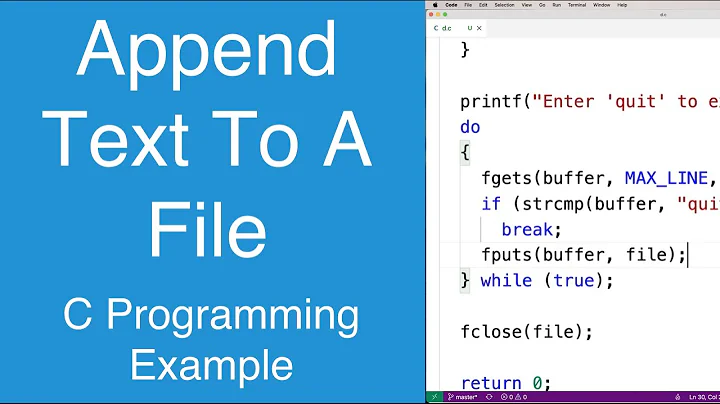How to add lines/text to the beginning of a file
Solution 1
Relatively elegant solution using POSIX specified file editor ex—at least elegant in the sense that this will handle any arbitrary contents rather than depending on a specific format (trailing backslashes) or a specific absence of format.
printf '0r headerfile\nx\n' | ex file-with-contents
This will open file-with-contents in ex, read in the full contents of the headerfile at the very top, and then save the modified buffer back to file-with-contents.
If performance is a SEVERE concern and the files are huge this may not be the right way for you, but (a) there is no performant general way to prepend data to a file and (b) I don't expect you will be editing your /etc/services file that often.
A slightly cleaner syntax (the way I would actually code this):
printf '%s\n' '0r headerfile' x | ex file-with-contents
A more complicated, but convergent, bit of code that will check whether the beginning of services EXACTLY matches the entirety of header, byte for byte, and IF NOT will then prepend the entire contents of header to services and save the changes, follows.
This is fully POSIX compliant.
dd if=services bs=1 count="$(wc -c < header)" 2>/dev/null |
cmp -s - header ||
printf '%s\n' '0r header' x |
ex services
A much simpler version, using GNU cmp's "-n" option:
cmp -sn "$(wc -c <header)" header services ||
printf '%s\n' '0r header' x | ex services
Of course, neither of these is smart enough to check for PARTIAL matches, but that's getting far beyond the ability of a simple one liner, since guesswork would be intrinsically involved.
Solution 2
OK I have decided to write an answer besides a comment.
You can use the i command of sed like:
sed -i '1i \
# The latest IANA port assignments can be gotten from\
# http://www.iana.org/assignments/port-numbers\
# The Well Known Ports are those from 0 through 1023.\
# The Registered Ports are those from 1024 through 49151\
# The Dynamic and/or Private Ports are those from 49152 through 65535\
#\
# Each line describes one service, and is of the form:\
#\
# service-name port/protocol [aliases ...] [# comment]' file
The is for GNU sed. For sed on Macs you need to use sed -i '' -e ...,
and for POSIX sed there is no simple way to do things in place.
Solution 3
Usually, you do just that. Prepending lines to a file is hard, since files are just sequences of bytes, so you'd need to move the existing data ahead to make space for the new data, and there's no direct method for that (at least no standard method). In theory, one might imagine a filesystem based on variable length records, where you could add new records at the start or between existing records, but that's not how it works in practice.
Some filesystems can move blocks of data around, but they're fixed-size blocks, and so not much use for text files, where the lines have variable lengths.
Even if you do something like sed -i or perl -i, they're going to create a temporary file behind the scenes just for that reason.
So, be it elegant or not, I'd go with:
cat prefix data > data.new && mv data.new data
For a few lines, you could use (in GNU sed):
sed -i.bak -e '1i first prefix line' -e '1i second prefix line' data
But generating the insert commands or adding backslashes for each line to be added isn't elegant either.
Related videos on Youtube
yael
Updated on September 18, 2022Comments
-
yael over 1 year
We have the following example file:
tcpmux 1/tcp # TCP port service multiplexer tcpmux 1/udp # TCP port service multiplexer rje 5/tcp # Remote Job Entry rje 5/udp # Remote Job Entry echo 7/tcp echo 7/udp discard 9/tcp sink null discard 9/udp sink null systat 11/tcp users systat 11/udp users daytime 13/tcp daytime 13/udp qotd 17/tcp quote qotd 17/udp quote msp 18/tcp # Message send protocol (historic) msp 18/udp # Message send protocol (historic) chargen 19/tcp ttytst source chargen 19/udp ttytst sourceHow may we append the following lines to the beginning of the file?
# The latest IANA port assignments can be gotten from # http://www.iana.org/assignments/port-numbers # The Well Known Ports are those from 0 through 1023. # The Registered Ports are those from 1024 through 49151 # The Dynamic and/or Private Ports are those from 49152 through 65535 # # Each line describes one service, and is of the form: # # service-name port/protocol [aliases ...] [# comment]So that the file will look like:
# The latest IANA port assignments can be gotten from # http://www.iana.org/assignments/port-numbers # The Well Known Ports are those from 0 through 1023. # The Registered Ports are those from 1024 through 49151 # The Dynamic and/or Private Ports are those from 49152 through 65535 # # Each line describes one service, and is of the form: # # service-name port/protocol [aliases ...] [# comment] tcpmux 1/tcp # TCP port service multiplexer tcpmux 1/udp # TCP port service multiplexer rje 5/tcp # Remote Job Entry rje 5/udp # Remote Job Entry echo 7/tcp echo 7/udp discard 9/tcp sink null discard 9/udp sink null systat 11/tcp users systat 11/udp users daytime 13/tcp daytime 13/udp qotd 17/tcp quote qotd 17/udp quote msp 18/tcp # Message send protocol (historic) msp 18/udp # Message send protocol (historic) chargen 19/tcp ttytst source chargen 19/udp ttytst sourceThe simple solution is to copy the original file to
file.bck, append the new lines to the file, and appendfile.bckto the file.But this isn't an elegant solution.
-
Alessio over 6 years+1. I was going to comment with your cleaner syntax second version, but it's already there. that's the way I'd do it....in fact, it's the way i have done it but with
edrather thanex. btw, one more advantage of usingedorexis that (unlike the-ioptions of sed or perl) it's a real in-place edit - the resulting file has the same inode as the original. -
don_crissti over 6 yearsThis doesn't edit the file in-place. If you just need to output the combined content of files to
stdoutyou can simply docat file1 file2there's no need to chain 3sedinvocations (and btw, this can be done with a singlesedinvocation) -
 Jeff Schaller over 6 yearsThis is worse than ilkkachu's very similar answer from 4 hours ago:
Jeff Schaller over 6 yearsThis is worse than ilkkachu's very similar answer from 4 hours ago:cat prefix data > data.new && mv data.new data, as yours will clobber file.txt if the initialcatfails (full filesystem?). -
 G-Man Says 'Reinstate Monica' over 6 yearsAlternatively,
G-Man Says 'Reinstate Monica' over 6 yearsAlternatively,cat prefix data > data.new && cp data.new data && rm data.newwill keepdatain the same inode (which is important if you have hard links, or if you need to preserve attributes like ownership or ACLs), at the cost of doing twice as much I/O. -
Nubarke over 6 yearsYou have a point there, but I did start the answer by assuming a normal, sane environment. A full filesystem is a rare condition, yet very easily noticed when it happens (and as such you can take special precautions, such as when working with a system out of memory). Otherwise, inserting an explanatory header into a regular text config file is rather unlikely to be the tipping point.
-
 Wildcard over 6 yearsThe thing is that for scripted solutions, you don't get to assume a sane operating environment. So at the very least an answer like this should have a big bold warning message that it should only be used interactively—and in that case, it really shouldn't be on one line (i.e. the semicolon should be a literal newline). The percentage of Production outages that are caused by lazy scripting that assumes a sane operating environment is probably in excess of 75%.
Wildcard over 6 yearsThe thing is that for scripted solutions, you don't get to assume a sane operating environment. So at the very least an answer like this should have a big bold warning message that it should only be used interactively—and in that case, it really shouldn't be on one line (i.e. the semicolon should be a literal newline). The percentage of Production outages that are caused by lazy scripting that assumes a sane operating environment is probably in excess of 75%.




